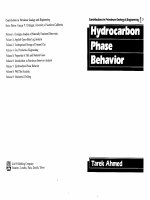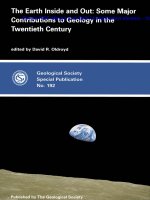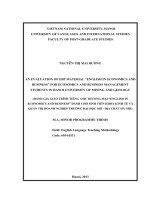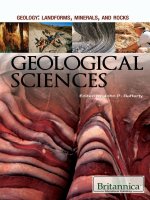Minerals in geology
Bạn đang xem bản rút gọn của tài liệu. Xem và tải ngay bản đầy đủ của tài liệu tại đây (1.35 MB, 45 trang )
Minerals
Chapter 3
Glencoe
Section 1
Minerals
• Objectives:
Describe characteristics that all minerals
share.
Explain how minerals form.
Journal Entry
• What is a mineral?
Minerals
• A mineral is a naturally occurring,
inorganic solid that has a definite chemical
composition and crystal structure. In order
for a substance to be called a mineral, it
must have all of the characteristics
described in this definition.
Inorganic
• A mineral must be inorganic, or not formed
from living thing or the remains of living
things.
Solid
• A mineral is always a solid. Like all solids,
a mineral has a definite volume and shape.
Chemical Composition
• A mineral has a definite chemical
composition. A mineral may made of a
single pure substance, or element, such as
gold, copper or sulfur. Most minerals are
made of two or more elements chemically
combined to form a compound.
Crystal Structure
• A mineral’s atoms are arranged in a definite
pattern repeated over and over again.
Atoms not confined, the repeating pattern
of a mineral;s atoms forms a solid called a
crystal. A crystal has flat sides that meet in
sharp edges and corners. All minerals have
a characteristic crystal structure.
• There are 2500 different kinds of minerals.
Crystal Structure
Crystals
Formation and Composition of
Minerals
• Many minerals come from magma, the
molten rock beneath the Earth’s surface.
When magma cools, mineral crystals are
formed. How and where magma cools
determine the size of the mineral crystals.
When magma cools slowly beneath the
Earth’s crust, large crystals form. When
magma cools rapidly beneath the Earth’s
surface, small crystals form.
Crystal Formation
• Crystals may also form from compounds
dissolved in a liquid such as water.When
the liquid evaporates, or changes to a gas, it
leaves behind the minerals as crystals.
Halite, or rock salt, forms in this way.
Most Abundant
Elements
• The eight most abundant elements in the
Earth’s crust are oxygen, silicon, aluminum,
iron, calcium, sodium, potassium and
magnesium. There are about 100 common
minerals formed from the eight most
abundant elements.Of these 100, fewer than
20 are widely distributed and make up
almost all the rocks in the Earth’s crust.
Rock Forming Mineral Groups
Chemical Classification
Mineral
Elements
Silicates
Feldspar, Pyroxene,
Olivine, Mica, Quartz
Silicon, Oxygen
Carbonates
Calcite, Dolomite
Calcium Carbonate
Oxides
Hematite
Iron
Sulfates
Gypsum
Sulfur, Calcium
Halides
Halite
Sodium, Chlorine
Mineral Identification
Section 2
• Objectives:
• Describe physical properties used to
identify minerals.
• Identify minerals using physical properties
such as hardness and streak.
Journal Entry
• What properties do we use to identify
minerals?
Identifying Minerals
• Minerals have certain physical properties
that can be used to identify them, such as
color, luster, hardness, streak, density,
crystal shape, and other special properties.
• Mineral Identification Part 1
• Mineral Identification Part 2
Color
• The color of a mineral is an easily observed
physical property. Color can be used to
identify only those few minerals that always
have their own characteristic color, such as
malachite which is always green. The
mineral azurite is always blue.
• Many minerals come in a variety of colors.
Some are colorless.Colors can also change.
Color
The Many Colors of Quartz
Luster
• The luster of a mineral describes the way a
mineral reflects light from its surface.
Certain minerals have a metallic luster, such
as silver, copper and gold. Minerals that do
not reflect light have a nonmetallic luster,
and are described by terms like glassy,
pearly, dull and silky.
Metallic Luster
Non Metallic Luster
Hardness
• The ability of a mineral to resist being
scratched is known as its hardness.
Hardness is one of the most useful
properties for identifying minerals.
Friedrich Mohs, a German mineralogist,
worked out a scale of hardness for minerals
ranging from 1 to 10. The number one is
assigned to the softest mineral, talc and 10
is assigned to the mineral, diamond.
Moh’s Scale
1-10









